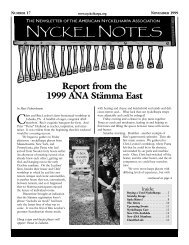Nyckel Notes #1, Oct 1995 - American Nyckelharpa Association
Nyckel Notes #1, Oct 1995 - American Nyckelharpa Association
Nyckel Notes #1, Oct 1995 - American Nyckelharpa Association
You also want an ePaper? Increase the reach of your titles
YUMPU automatically turns print PDFs into web optimized ePapers that Google loves.
<strong>Nyckel</strong> <strong>Notes</strong> <strong>Oct</strong> <strong>1995</strong> 4<br />
tune or two. Concentrate on keeping the fingers<br />
where they’re needed, and don’t shrink the hand<br />
back to its lowest position when you’re not playing a<br />
3rd- or 4th-finger note.<br />
The right hand<br />
The right hand and the bow are topics for an<br />
ongoing discussion. For this time I’ll say only that<br />
the bow should touch the string about halfway<br />
between the keybox and the bridge, and that it<br />
should be held and move, as much as possible, at<br />
right angle to the string. It takes a while to find a<br />
comfortable position, and longer to develop an easy,<br />
fluid motion. And the nuances of bow hold and fine<br />
control of bow pressure can be an ongoing project -<br />
but that’s what makes the harpa a continuing<br />
education.<br />
If you don’t already play a string instrument, get<br />
someone to show you the right way to hold a bow.<br />
Experiment with the pressure of the bow on the<br />
string - from so hard that it’s staticky and unpleasing<br />
to so light that it’s quiet and wispy. And play, and<br />
play, and play; all this makes more and more sense<br />
as you go along.<br />
In future articles<br />
There’s a lot to this crazy instrument. There are<br />
left-hand position changes, to get those higher<br />
notes on the A-string. There are trills and other<br />
articles. Drop me a note through the ANA, or at 46<br />
Sleigh Road, Chelmsford MA 01824.<br />
Matt Fichtenbaum first met the nyckelharpa in<br />
Sweden in the mid-70’s and considers it a lifetime<br />
project. He has taught nyckelharpa in both Sweden<br />
and the US and plays regularly for dances in the<br />
Boston area. Matt also plays fiddle and is reviving<br />
the piano as a traditional Swedish folk instrument.<br />
<strong>Nyckel</strong>harpa Care<br />
by Bart Brashers<br />
Tuning your nyckelharpa can be problematic,<br />
especially if you play a lot with fiddles. One melody<br />
will sound fine, but the next one will sound out of<br />
tune, sour. The problem often stems from using the<br />
equal-interval scale, which was developed for the<br />
organ and the piano (and other classical<br />
instruments), so that it can play in any key and still<br />
sound reasonably good. The “distance” between<br />
each of the notes is the same, regardless of where<br />
you are relative to the current tonic note (the current<br />
key). This makes the piano sound equally good in<br />
all keys, something that was important to people like<br />
Bach, who wanted to change keys a bunch of times<br />
in the same piece. This also makes the piano<br />
sound equally bad in all keys. Fretted instruments<br />
like guitars also use this scheme, called a<br />
Eric Sahlström’s fine-tuning scheme<br />
Note: G# Eb Bb F C G D A E B F# C#<br />
Cent: 0 +2 +4 +6 +4 +2 0 -2 -4 -6 -4 -2<br />
Rank: 5th 4th 3rd 2nd 1st 2nd 3rd 4th 5th 6th 7th 6th<br />
Bart’s fine-tuning scheme<br />
Note: G# Eb Bb F C G D A E B F# C#<br />
Cent: -2 0 +2 +4 +6 +4 +2 0 -2 -4 -6 -4<br />
Rank: 6th 5th 4th 3rd 2nd 1st 2nd 3rd 4th 5th 6th 7th<br />
ornaments. There are double-stops. For the right<br />
hand there are slurred notes and bowing patterns<br />
and, most importantly, making tunes danceable:<br />
playing so that the rhythm comes through. There’s<br />
achieving good tone, and shaping and articulating<br />
the notes, and "doppning" - bowing double-stops so<br />
that the lower note is struck lightly and briefly. And<br />
there are more exercises, and particular tunes that<br />
have exercise value - listen to the second part of<br />
"Trollrikepolskan" for one example.<br />
I’m here to be helpful: I’m interested in your<br />
thoughts and what you’d like to see in future<br />
“tempering”. Violinists can and do adjust their<br />
fingers as they play to temper their scale. Many old<br />
nyckelharpas in museums seem to have non-piano<br />
temperings, but we can’t be sure they haven’t been<br />
randomly adjusted by the passage of time and all<br />
the knocks the harpas have taken.<br />
The thing is, nyckelharpa players don’t play in every<br />
key! We are then free to optimize the tempering for<br />
the keys we commonly use. Since I don’t play any<br />
tunes is the keys of F#, C# or G#, it doesn’t make<br />
sense for me to use a tempering that prioritizes<br />
those keys as highly as F, C and G.
















